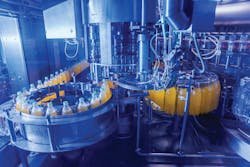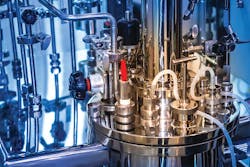Hydraulic hose, tube and fittings: The right combinations to reduce downtime and increase service life
The principle behind today’s modern hydraulic systems started in the mid-17th century when French mathematician and physicist Blaise Pascal concluded: A change in pressure at any point in an enclosed fluid at rest is transmitted undiminished to all points in the fluid.
From chemical processing to oil and gas processing to food and beverage processing, the correct selection of hydraulic components is critical to the change in pressure, safety and service life of the system. Regardless of the industry, and depending on the specific operating requirements, a single system can have both flexible hose and metal tubing. One part of the system may have moving parts operated by hydraulic fluid, which require flexible hose, while another part of the system carrying food product (i.e. beverages) requires a stainless steel tube and fittings that are stationary.
Stainless steel hydraulic fittings are best for food and beverage processing applications, while hydraulic fracking (which carries hydrochloric acid, oil and water) requires special high-pressure hydraulic hose assemblies. Hydraulic fracking hose assemblies may have fittings and flanges made of carbon steel, stainless, Hastelloy, Monel, Duplex or other alloys.
Process versus discrete manufacturing
Though seemingly basic, it is important to know the distinction between process manufacturing and discrete manufacturing.
In process manufacturing, goods are produced by combining ingredients, raw substances and supplies, using formulas or recipes — such as in the food and beverage, chemical, petroleum and pharmaceutical industries. On the other hand, discrete manufacturing produces finished goods that are distinct, and specific items considered individual units. Discrete manufacturing is the process for making items as simple as nuts and bolts, to complex items such as automobiles and computers.
Selecting the correct hose, tubing and fitting
The proper selection of hose and tubing size, material and configuration — along with the correct fittings and flanges — is imperative in the design of all processing equipment.
Fitting selection comes down to a popular and well-known acronym dictated by the system’s requirements. STAMP: Size, Temperature, Application, Media and Pressure. Each of these five considerations must be taken into account for accurate system design and configuration. Yet in some circles, two more letters have been added that may seem obvious, but cannot be overlooked. STAMPED: E for the Ends (i.e., couplings) and D for Delivery (i.e., volume and velocity). The couplings are obviously the fitting selection, and the compatibility of media volume and velocity are highly important to a process system. Volume is the amount of fluid flow per unit time and is typically measured in gallons per minute (GPM), while velocity is the distance that a fluid travels per unit time, measured as feet per second. These are key considerations when selecting hose or tubing material and length, as well as wall thickness and burst pressure rating. Then there is the choice of the proper fitting connection. The system is only as good as the compatibility of the fitting and hose or tubing.
The wrong fitting style, material or installation can cause catastrophic system failure and even become a safety issue. At the very least, it will cause leaks, and system leaks are not a small problem. Millions of gallons of hydraulic fluid are wasted each year, mostly due to system leaks. The cost of fluid loss itself can be tens of thousands of dollars from one system. Fluid leaks can also cause equipment damage because of loss of lubrication, which creates premature wear and system failure. When a system goes offline due to any kind of failure, it causes unplanned downtime and production output is lost, resulting in what can be a significant loss of revenue and an increased cost of maintenance and repair. Most leaks and system failures are not due to inferior components, but primarily due to incorrect selection of components or improper installation.
Hoses, tubing and fittings are the critical elements of all hydraulic systems. They transmit fluid from the pump to valves, actuators and motors, and generate the force and motion to make the system work. The importance of selecting the correct hose, tubing and coupling is what allows a processing system to be repeatable and reliable, while reducing or even eliminating costly downtime. The correct sizes, materials and configurations are what ensure system dependability. Proper selection of the hose or tubing is crucial. But not matching it to the compatible fitting that is specific to the application will only increase the chances of system failure.
For hose and tubing, first understand the compatibility of the fluid that is to be transferred with the material of the hose or tube and its required pressure. Consider the media or material that is to be transferred, the chemical resistance of the hose or tubing, and the working pressure and temperature. Select hose and tubing that meets the required ratings for standard operating pressure, burst test and impulse life. Proper hose and tubing selection lowers cost of ownership and avoids downtime and unscheduled maintenance, which ultimately maximizes uptime and improves ROI of the system.
For the compatible fitting, as with hose and tubing, there are a number of important factors to consider, including:
- Attachment (i.e., a crimped hydraulic fitting for a hose, and a compression fitting for tubing)
- Fitting configuration (straight, elbow, tee, etc.)
- Flow
- Compatible material of hose or tubing
- Size of hose or tubing (in some cases consider wall thickness)
- Vibration
- Working pressure (maximum PSI)
Additionally, consider whether an elastomeric seal is to be used, such as an O-ring or gasket. Critical components in O-ring face seal fittings and most flange assemblies are an elastomeric seal. The O-ring material selection is dependent on the factors mentioned above, particularly chemical compatibility of the media being transferred and system pressure.
Flange connections are often used in applications that will encounter exceptionally high pressures in larger diameter tubing or piping. They can be bolted together to mate two sections of pipe (tubing or hose) or bolted or screwed into the component to secure a flange fitting or section of pipe.
Regardless of pressure, it is also important to consider flanges where there may be a need to disassemble the connection for easy access to modify, clean or inspect the system. Certain flanges may also be permanently welded together or onto the port section of the component (e.g., motor housing, valve port, etc.). The most common flange sizes range from ½-2 ½ inches, and in processing systems they are SAE O-ring flange code 61 or 62. Flange connections are frequently found in injection molding machinery, chemical processing and food and beverage processing.
Sanitary lines and fittings
In many process applications — especially food and pharmaceuticals — sanitary lines and fittings must be used whenever the system is carrying product (media) that cannot be contaminated by bacteria.
As required by the Food and Drug Administration, sanitary or hygienic fittings and tubing must be cleanable, either manually or by clean-in-place (CIP) processes. CIP refers to the cleaning of tubing, pipes, filters, fittings and the entire interior of process equipment without disassembly.
Sanitary system components must be corrosion-resistant and be free from pockets, threading or tight bends where bacteria can form or be trapped. Most sanitary system components are made of specific stainless steel alloys. In addition, sanitary tube fittings must have surface finishes rated by its Roughness Average (Ra). Even stainless steel can harbor bacteria in microscopic peaks and valleys in the surface finish. Therefore, sanitary fittings are specially polished to reduce, or sometimes completely remove, this surface roughness.
Conclusion — The cost of unnecessary downtime
In the design of process equipment hydraulics, the goals are to reduce or eliminate frictional losses in transfer lines and equipment, promote optimal operating conditions and increase service life of the system. Each of these individual design considerations must be compatible with each other prior to the total system design.
Processing systems in any application or market can be very complex, critical or sensitive. In addition, the impact of downtime due to component failure can be costly. Research conducted by Aberdeen Group found unplanned downtime in most businesses could exceed costs of $250,000 per hour.
Consider subsea separators and processing units, which include many different processes, such as single- and multi-phase boosting of well fluids, sand and solid separation, subsea water removal and gas or liquid separation. These systems can be many thousands of feet underwater and weigh up to 1,000 tons each. It is not hard to imagine that the cost of raising a subsea separator to the surface for maintenance can be prohibitive. That is why components in these systems are required to withstand the harsh deep-sea environment and remain on the seabed without the need for maintenance for at least five years.
In addition, and as has been mentioned, the critical nature of component selection in food and beverage processing equipment is imperative to avoid contamination and unexpected downtime. The wrong component type, size, material or configuration can lead to equipment breakdown and mechanical failures that can be extremely costly. Most food and beverage operations are continuously producing large volumes of product. The losses due to equipment failures for food manufacturers can be significant — not just from loss of production time, but often the impact of food or drink ingredient spoilage can be a major portion of downtime losses.
Extended service life, plus reduced maintenance and downtime are largely driven by proper hose, tubing and fitting selection. These factors have a primary influence on managing operational costs and achieving revenue goals.
A 30-year hose industry veteran, Joe Lark is Motion Industries' Product Manager for Hose. Before his 10 years with Motion Industries, Joe spent 20 years with Monroe Rubber and Plastics Supply Company (now a unit of Motion Industries), with the last 10 as President/Owner. He is a past president of NAHAD (National Association of Hose and Accessory Distribution) and is the committee lead for developing “Hose Assembly Guidelines” for NAHAD.
Scott Schechtman is the National Account Manager at Brennan Industries, a leading manufacturer of Hydraulic, Pneumatic and Instrumentation fittings, adapters and accessories. Scott has spent the majority of his career building relationships and adding value to key customers around the globe.



